I have been fascinated with gargoyles since I was very young. And saw pictures of Notre Dame Cathedral in an encyclopedia. I didn’t fear the figures but instead some of the faces that were depicted on the structure’s walls. I have never claimed to be normal y’all.
Meanwhile, it might be fun to learn about the history, lore, and some of the styles of gargoyles and then share all of this with you. As I’m learning with this blog, I think things will go one way. Because I know something along the way. For example, the figures I like are technically called grotesques. Yeah, I didn’t see this curveball coming. First, let’s start by explaining the difference between a gargoyle and a grotesque.
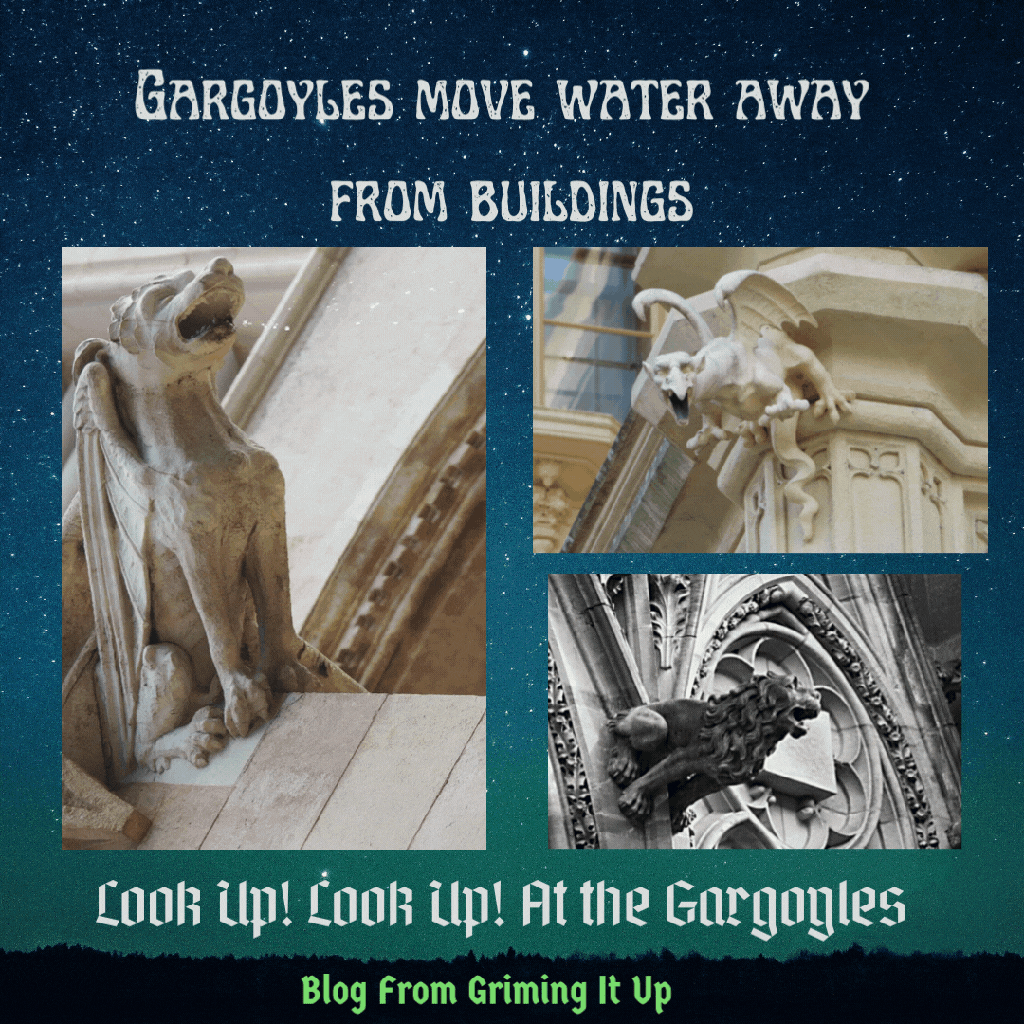
A gargoyle is a figure projecting from the gutter of a building that acts as a spout to carry water away from the building. Gargoyles are a true architectural feature; their purpose is to keep water from destroying the building and its foundation. There are still many really cool, strange, and downright bizarre versions of gargoyles that I can appreciate. The word “gargoyle” is an English derivative of the French word gargouille, which actually comes from the word meaning “to gargle.”
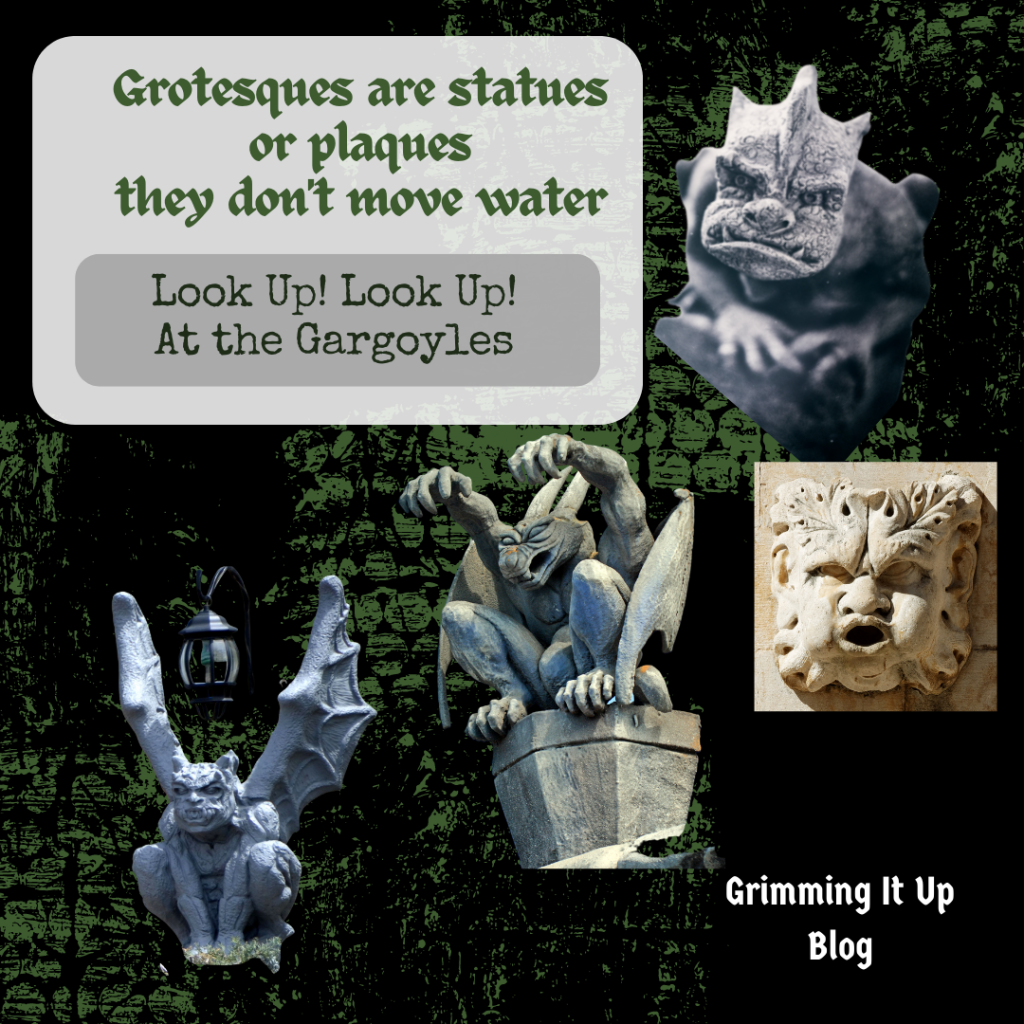
A grotesque is a decorative art style characterized by fanciful or fantastic human and animal forms, often interwoven with foliage or similar figures, that may distort the natural into absurdity, ugliness, or caricature –Merriam Webster. Lastly, it specifies a statue or a face that is strictly decorative but distorted as a point of the definition. I have been calling all my figurines by the wrong name for over forty-five years!
One more interesting tidbit: a hybrid of two or more creatures is known as a chimera. Think of Harry Potter’s Fantastic Beasts. The griffin (or griffon) is an excellent example of this, with the body, back legs, and tail of a lion and the head and wings of an eagle. An Important point, before we get further, a gargoyle can also be a grotesque, but a grotesque can’t be a gargoyle.
Egypt, Rome, and Greece
In ancient Egypt, gargoyles (technically, most were grotesques) were often depicted as lions, griffins, and sphinxes. In Rome and Greece, a mixture of actual gargoyles and grotesques was used in their architecture. Fun fact: the Temple of Zeus in Greece originally had one hundred and two gargoyles. Most of the gargoyles in the temple were so heavy that they eroded and broke off the structure. There are only about thirty-nine of the original gargoyles left today.
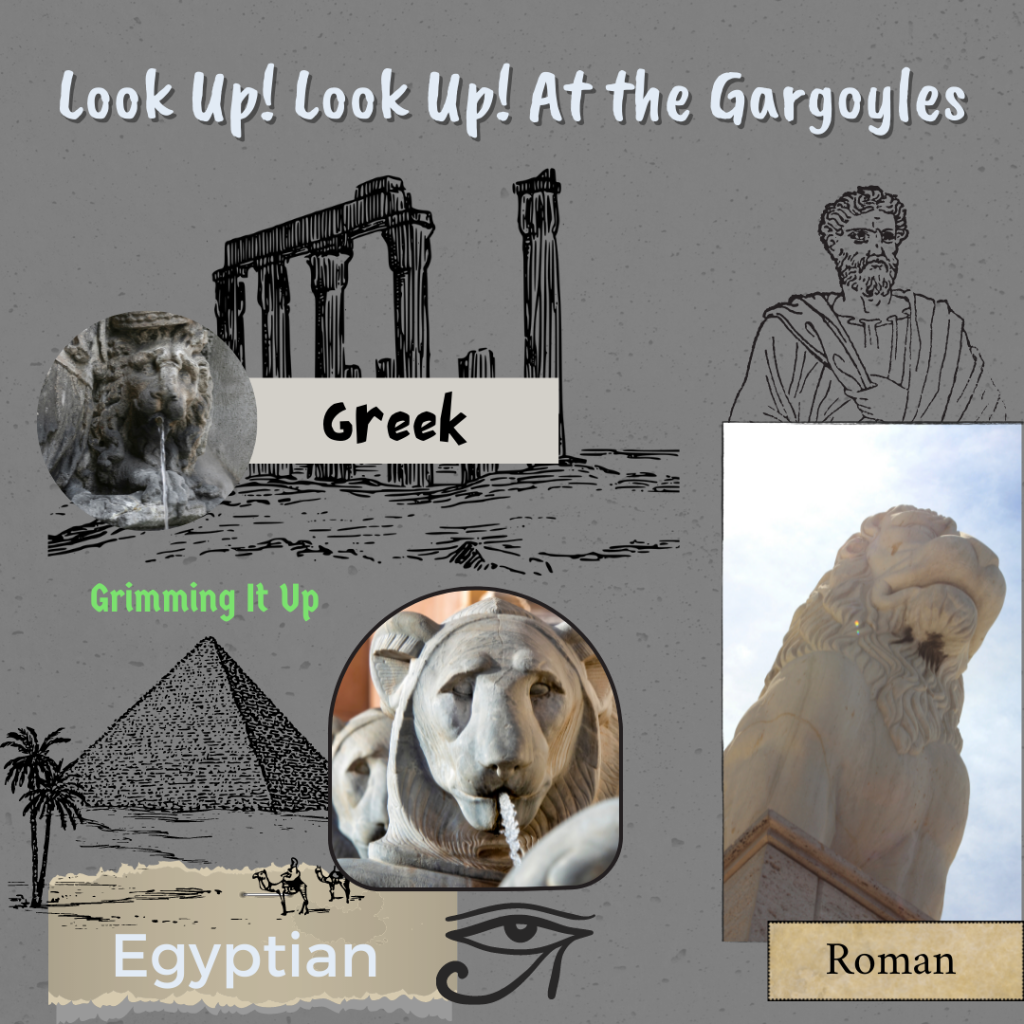
Many have faces showing a full range of emotions, and others would fall into, shall we say, risqué positions such as a butt. Yeah, I’m going to let you all Google that image. Thanks a lot, Google!
China

I’m sure other cultures in Asia also have versions of gargoyles and grotesques, but for the sake of simplicity, I’m only going to investigate China for now. In China, they’re called roof charms, 檐兽. On a few of the buildings I saw in the pictures, the gargoyles are depicted as dragons! I love this stuff—maybe a little too much.
Don’t worry; I can hear some of you asking about the lions by doorways. Well, those are a Chinese version of a grotesque, and they’re called shi or shi-shi. A shi is a protection symbol that guards entranceways to buildings and homes. They’re always in pairs, and traditionally, they’re carved from decorative stone in the shape of lions. The significance of the lion is that it indicates safety and luck in China. It seems they, too, see gargoyles and grotesques as protectors.
Mexican Gargoyles
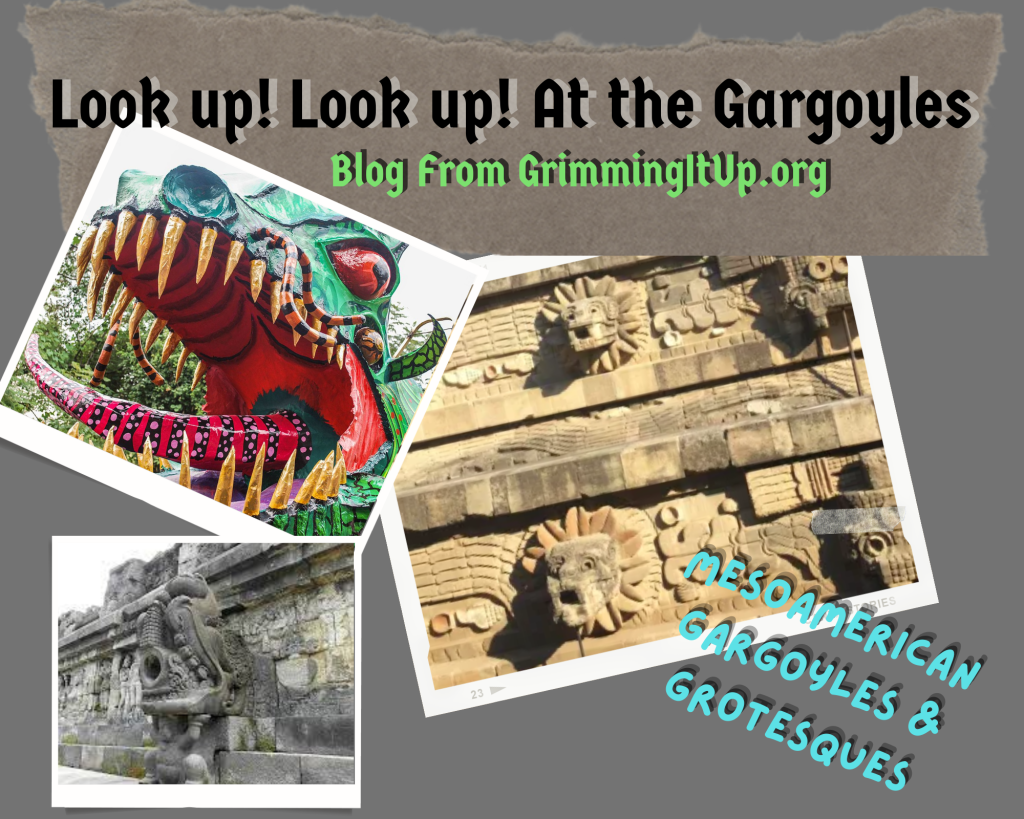
I must ask if we shouldn’t also include the ancient Mayan and Aztec cultures in this. For example, many important buildings in Mexico City are adorned with gargoyles. Places like pricy homes, government buildings, and churches have gargoyles. These examples are newer, and likely came with the Spanish influence of the conquistadors, since they seem to have more of a European gothic influence.
What about places like the City of the Gods, Teotihuacan? There are dozens of gargoyles and grotesques on ruins in this UNESCO World Heritage site, including the famous Temple of Quetzalcoatl. These take the shape of a Mayan sun god! They’re thousands of years old as this temple has parts dated as far back as 350 BCE.
Modern-day Mexico City has celebrated since 2007 for the alebrije. The alebrije is a form of Mexican folk art in which brightly colored paper mache sculptures are made in the shapes of fantastical beasts. Some are dragons, jaguar-men, and other grotesques. The participants take part in the Monumental Alebrije Parade through the city. What a fun festival this must be!
Gargoyles & Gothic Architecture
Gothic architecture is fantastic! I’m not an architect, nor am I an art history major, so I’m only going to do a brief overview of gothic architecture. However, the source below, A Beginners Field Guide to Gargoyles, is an excellent scholarly reference.

Gothic architecture was a style in Europe. At its peak from the late twelfth century through the sixteenth century, it was known for five key elements: large stained-glass windows, pointed arches, ribbed vaults, flying buttresses, and ornate decoration. The last element, is the place where gargoyles are featured most prominently.
Notre Dame and its Gargoyles
Gargoyle Lore
The French legend of “La Gargouille” tells of a dragon that terrorized the town of Rouen. The gargouille was said to have bat-like wings, and a long neck, and he would breathe fire. This went on for centuries. The dragon swallowed ships and devoured young women and children, and would flood the town until around 600 CE.
When a priest called St. Romanus told the town, that he would slay the dragon only if everyone converted to Christianity. The townspeople agreed. St. Romanus made the sign of the cross and then led the dragon into town, where it was either burned or thrown into the Seine, depending on which source you read. In the burning version, the creature’s head wouldn’t burn and was cut off and added to the local church while the ashes of the body were thrown into the river. The gargouille’s head became a ward against evil and other dragons.
Pop Culture References to Gargoyles
In our modern age, pop culture has undoubtedly shaped our ideas and, in my case, misconceptions of gargoyles and grotesques. For example, I was an adult when Disney released the cartoon series Gargoyles, but I watched it faithfully anyway. Naturally, I tried to say the guilty pleasure was for my toddler daughters, who honestly couldn’t have cared less.
Though maybe, the movie version from Disney of the Hunchback of Notre Dame was another story. My oldest Grim did wear out that first VHS tape. To this day, when I hear the name Goliath I don’t think of the biblical reference; no, it’s the cartoon series.
Next, I found the movie I, Frankenstein, and those gargoyles depicting angels. I can go on and on and on. I thought y’all might enjoy a list of some other pop culture references to gargoyles. Hopefully, some will bring back memories for you as well.
Thanks to pop culture, we were taught that gargoyles were stone statues that came to life to protect humans. Some more imaginative sources gave the gargoyles (grotesques) magical powers.
Literature References:
Weird Tales 1932, Alater Ashton Smith Magazine
The Horn of Vapula published in 1932
Movies
1932: Maker of gargoyles, movie
1971: Dr. Who (Bok was the name of the gargoyle) Season 8 The daemons: Episode 1-5
1972: Gargoyles, a movie based out of New Mexico
1974: Dungeons & Dragons, the white box set
1984: Ghost Busters, the gargoyles were represented as hell hounds
The 1990s: Disney’s Gargoyles Animated series (originally aired from October 24, 1994, to February 15, 1997, for three seasons & 78 half-hour episodes)
1996: Hunchback of Notre Dame from Disney (the three gargoyles were Victor, Hugo, and Laverne)
2004: Gargoyle, movie
2007: Reign of Gargoyles movie
2014: I, Frankenstein (If you have seen this, what is your take on the gargoyles in this movie? Benevolent? Historians, or general turds?)
2016: Fallen, a movie
2018: Ophelia, a movie
Alien Gargoyle Went Viral
Does anyone remember the memes that went around on Facebook about the alien gargoyle in 2013? I saw many of these with speculations that claimed aliens exist, as evidenced by this carving, or that it was proof of time travel. As a result, I was greatly entertained by each of these while secretly wondering about the actual origin. The short clip below gives an informative history of just where this gargoyle came from.
Fun Places To See Gargoyles Today
Here is a list of some of the more famous places where you can see some gargoyles from around the world and the US. Please remember that these are not all the places, just some of the ones I thought were fun. In one of the references, someone else used a term that I’m adding to my list of things to do: gargoyle hunting. I absolutely adore this idea!
Europe & Asia
- St. Vitus Cathedral, Prague, Czech Republic
- Merton Chapel College, Oxford, England
- Westminster Abbey, London, England
- Chapel of Bethlehem, France (they have gremlins!)
- Notre Dame Cathedral, Paris, France
- Ulmer Munsler, Ulm, Germany
- Duomo di Milano, Milan, Italy
- Eikan-do, Japan
- Batalha, Portugal
- Pena Castle, Sintra, Portugal
- Dragon Bridge, Slovenia
- Puente del Reino, Valencia, Spain
United States
- Chrysler Building, New York City, NY
- Denver International Airport, CO (this is an interactive one!!) https://youtu.be/fKVOtx7Blfk )
- Eastern State Penitentiary, PA
- Downtown Dragons, walking tour, Pittsburgh, PA https://www.phlf.org/dragons/
- National Cathedral, Washington DC
Darth Vader Washington DC
In the 1980s, there was a contest for kids to design a gargoyle at the Washington National Cathedral. The winner, Christopher Rader, proposed a Darth Vader gargoyle. What thirteen-year-old wouldn’t want to have this for bragging rights? It was installed on the “dark side” or north wall. As a result of my research, it seems Vader is a little hard to spot, so the cathedral offers a guide. https://cathedral.org/what-to-see/exterior/vader-2/
Throughout my wanderings, I have seen various gargoyles and grotesques in cities around the United States and Germany. I’m willing to bet other members of the Grim family have too. My biggest suggestion would be to look up and marvel at the wonders around you. If you are of the mindset that cathedrals are a great place to tour, you’re bound to have one close by that will have eye candy. Have fun gargoyle hunting, and please do share your pictures on our Facebook page. Who knows? Maybe we can add them to a collaborative list and make it more entertaining for us all.
Our Gargoyles & Closing Thoughts
I wanted to share some of our versions of gargoyles with y’all. Many were store-bought and repainted, others resculpted and painted, and a few were gifts we enjoy. We hope you find the version that brings you happiness. I’ll stick with the notion that they protect our home.

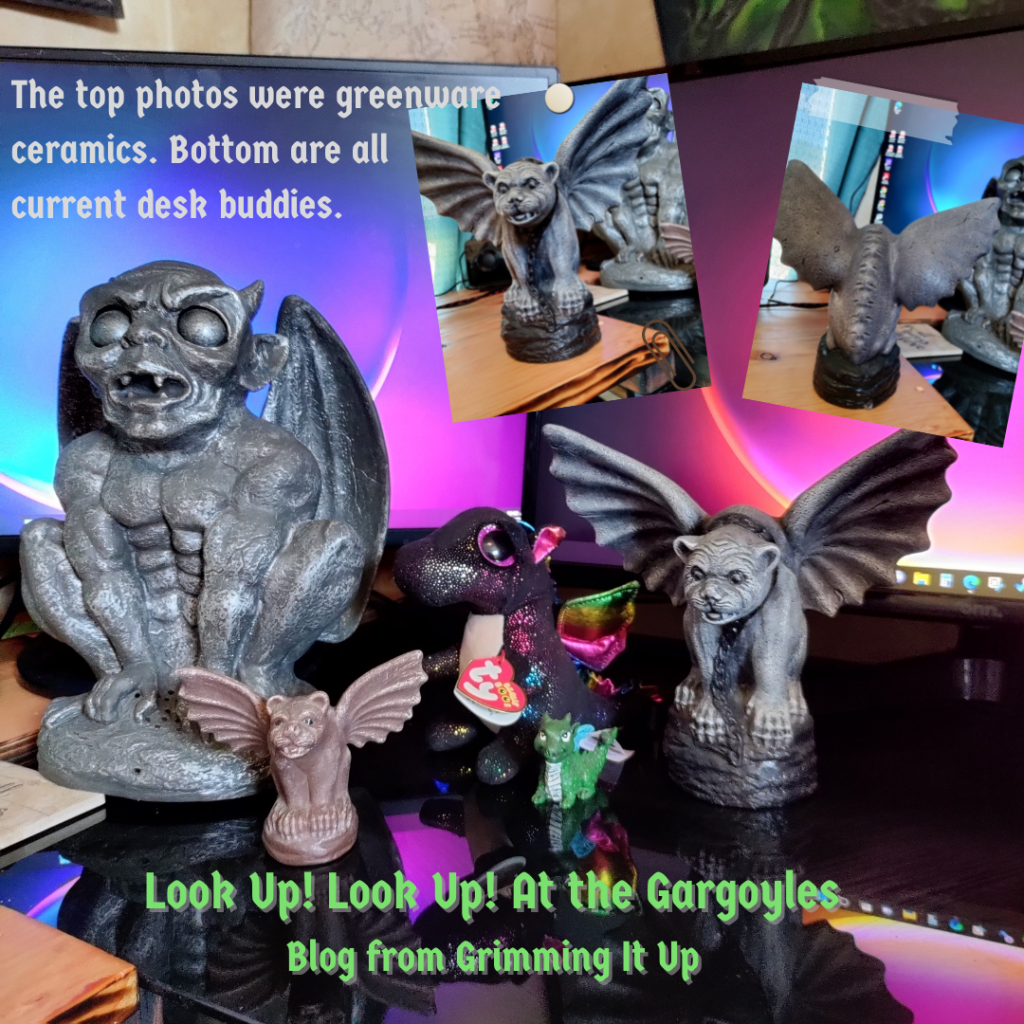
Thank you for spending time with us today. We appreciate each and every one of you!
Sources
https://www.ancient-origins.net/artifacts-other-artifacts/gargoyles-0012253
https://lainhart.medium.com/legend-of-the-gargoyle-5c30e063a37f
http://northstargallery.com/gargoyles/aboutgargoyles.htm
https://www.travelchannel.com/interests/haunted/photos/gargoyles
https://en.wikipedia.org/wiki/Alebrije
https://en.m.wikipedia.org/wiki/Gargoyle
https://en.wikipedia.org/wiki/Teotihuacan

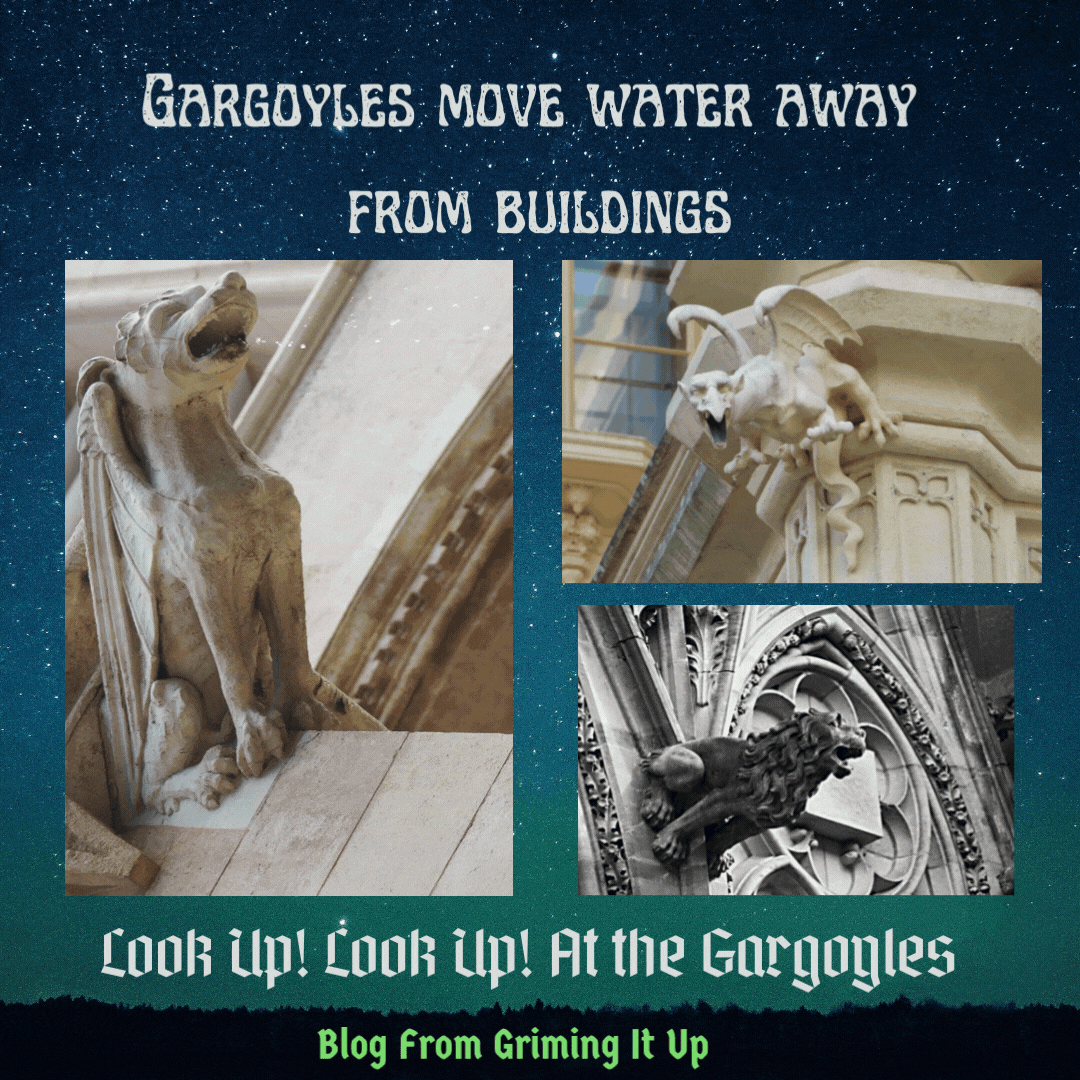
One response to “Look Up! Look Up! At the Gargoyles”
Thank you for your kind words Hai Redington.